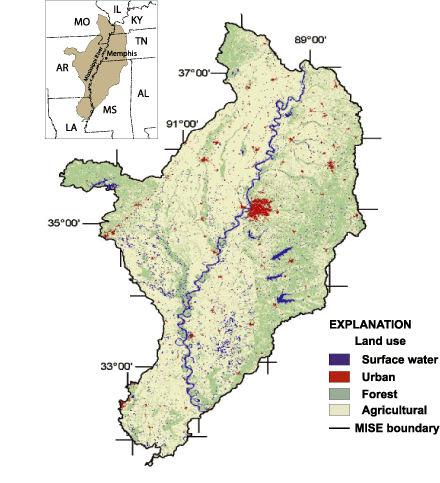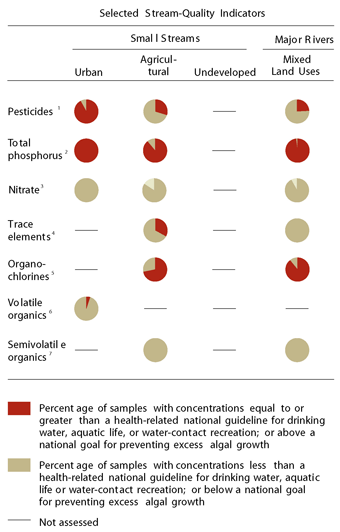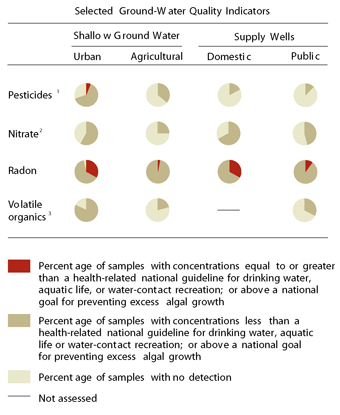SUMMARY OF MAJOR FINDINGS
 |
| The Mississippi Embayment (MISE) Study Unit is an approximately 49,800-square-mile area in the six States of Arkansas, Kentucky, Louisiana, Mississippi, Missouri, and Tennessee. Land use in the MISE is principally agricultural. Approximately 62 percent of the study area is agricultural, 33 percent is forested, and 5 percent represents other land uses. The land use in some of the smaller drainage basins sampled is greater than 90 percent agricultural. |
Stream and River Highlights
The climate, rainfall, soil type, and surficial geology of the Mississippi Embayment (MISE) Study Unit strongly influence land use in the basin and subsequently influence water quality. About 62 percent of the Study Unit is used for agriculture. In areas of intensive row-crop production, as much as 90 percent of the land is used for agriculture. This influence from agricultural land use, with additional contributions from urban areas, has resulted in streams that often have high turbidities, mixtures of pesticides, and degraded riparian habitat. Biological communities in the streams commonly are stressed. However, human activities on the Earth’s surface seem to have a limited effect on the ground-water resources, which supply the vast majority of the region’s drinking water.
- Herbicides frequently were detected in streams draining agricultural or mixed land-use basins; insecticides were detected less often. Pesticides in over 60 percent of samples collected from these streams exceeded aquatic-life guidelines. Insecticides frequently were detected in samples from the urban stream; diazinon and chlorpyrifos were detected in every sample, usually in concentrations above aquatic-life guidelines.
-
Nitrogen concentrations in the MISE generally were in the middle range of the national data, whereas total phosphorus concentrations were in the 67th to 93d percentile. The phosphorus concentrations in the Study Unit probably were related to many factors, such as rainfall amounts, soils, and artificial drainage of agricultural fields. No sample exceeded the guidelines and standards for nitrate or ammonia, but most exceeded the U.S. Environmental Protection Agency’s (USEPA) goal of 0.1 mg/L (milligram per liter) of phosphorus for the prevention of plant nuisances in streams.
1 Insecticides, herbicides, and pesticide metabolites, sampled in water.
2 Total phosphorus, sampled in water.
3 Nitrate (as nitrogen), sampled in water.
4 Arsenic, mercury, and metals sampled in sediment.
5 DDT and PCBs sampled in fish tissue.
6 Solvents, refrigerants, fumigants, and gasoline compounds sampled in water.
7 By-products of fossil-fuel combustion; components of coal and crude oil sampled in sediment. - Although the sale of the organochlorine insecticide DDT was discontinued in 1972, DDT and metabolites (chemicals resulting from the breakdown of DDT) were widespread within the MISE. DDT, or one of its metabolites, was found in every fish tissue sample collected and was found in 67 percent of the streambed-sediment samples. Detectable levels of a metabolite of DDT were measured in 14 percent of surface-water samples.
- Although volatile and semivolatile organic compounds often were detected in urban stream water and in bed sediment, they were rarely at levels of concern.
- Aquatic organisms present in the MISE streams were typical of those found in impacted or degraded streams. Fish communities in most of the streams were dominated by fish tolerant of poor water quality conditions. The aquatic insects and algal communities generally were tolerant of turbid, silty conditions.
- Methyl parathion, a metabolite of DDT, and several other pesticides were detected in air and rain samples collected in an agricultural area and in the urban area of Jackson, Mississippi.
| Major Influences on Streams and Rivers
|
Ground-Water Highlights
Ground-water quality in the Mississippi Embayment Study Unit generally is very good. Ground water in the deep Tertiary aquifers, which supply most of the region’s drinking water, generally is isolated from surface activities by thick “confining layers” of clays. Surface activities influence ground water where shallow deposits cover the hills in the eastern part of the Study Unit and in the Memphis shallow aquifers more than in the deeper aquifers. The abundant ground water in the alluvial aquifer of the Mississippi River valley is near the land surface but is covered by dense clays.
- Pesticides, such as atrazine, simazine, and metolachlor, were detected most frequently in the ground water in the shallow deposits that cover the hills in the eastern part of the Study Unit and in ground water underlying urban areas. Bentazon, molinate, and fluometuron were the pesticides most frequently detected in the alluvial aquifer. Atrazine and dieldrin were detected one time each in shallow urban wells at levels above the drinking-water standards and guidelines.
- Nutrient concentrations in the ground water in the MISE generally were low. All nitrate concentrations were below the USEPA drinking-water standard of 10 mg/L.
- Radon is naturally occurring and was detected in almost every well sampled. Concentrations above the USEPA- proposed drinking water standard of 300 picocuries per liter were found in water from only 16 of 109 wells. These levels are low, relative to levels detected in other NAWQA Study Units.
- Volatile organic compounds (VOCs) were detected in ground water throughout the Study Unit; however, concentrations were well within drinking-water standards. The most frequently detected VOCs were 1,2,4-trimethylbenzene and carbon disulfide.
 |
| 1 Insecticides, herbicides, and pesticide
metabolites, sampled in water.
|
| Major Influences on Ground Water
|
| Table of Contents || Previous Section || Next Section || Glossary U.S. Geological Survey Circular 1208 Suggested citation:
|

